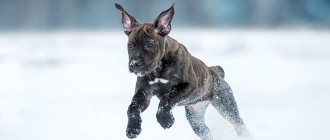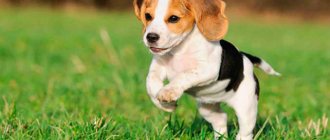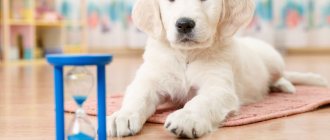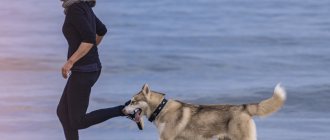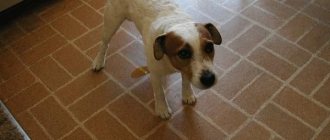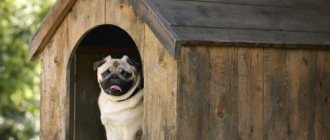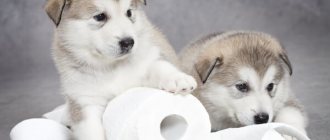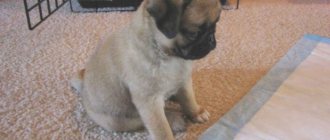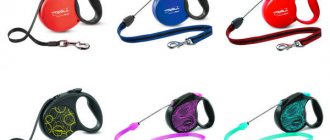Bathing a dog is a mandatory hygienic procedure that allows you to maintain the cleanliness and health of the animal’s coat and skin. Proper use of hygiene products and knowledge of the intricacies of the process will allow the owner to care for his shaggy friend without much hassle. Water treatments for different breeds of dogs have their own characteristics and depend mainly on the size of the pet and the structure of the coat.
When and how often should you wash your dog?
As a rule, physiologically dogs need bathing with detergents (including special additives and effects) twice a year - when shedding. This makes it easier to shed old fur and gain an aesthetic appearance.
How often to bathe a dog
To care for your pet's fur and skin, veterinarians recommend washing it no more than once every 1-2 months.
If your pet lives in the yard, then you will not have to worry about bathing it often. But if you are the owner of a long-haired dog with soft fur, especially if it regularly participates in exhibitions, then be prepared for frequent water treatments.
Despite the fact that smooth-haired dogs produce more sebum, it is recommended to wash them no more than once every two months, but using a special shampoo for short-haired dogs, which cleanses the coat well and helps maintain its normal appearance longer.
Photo: mountainpugs
Long-haired dogs can be bathed more often, once a month, with a shampoo designed specifically for them, as their coat requires special care. For breeds with soft coats, you can additionally use a coat conditioner to make brushing easier.
Hairless (hairless) dogs also need to be bathed with a special shampoo and not often. It is recommended to additionally use moisturizing creams or oils that restore skin unprotected by fur.
Domestic dogs of small breeds, which are rarely outdoors, should be bathed even less frequently - approximately once every three months. The exception is the Yorkshire Terrier and Papillon - the characteristics of their skin intensively producing sebum make bathing necessary every one to two weeks.
When to bathe a dog
There are a number of other cases when washing your dog is necessary.
The dog got dirty.
Dogs are active and curious and get dirty quite often: sometimes by accident, but often they can deliberately roll out in dust, dirt, or, succumbing to ancient instincts, even in garbage and feces.
You can't do without swimming here. Photo: Kol Tregaskes
Hygiene procedures cannot be avoided here.
We need to get rid of the “dog” smell.
Also, washing a pet is indicated when a specific dog smell (dog smell) appears, if this causes inconvenience to the owner.
Skin problems.
For some diseases (fleas, ticks, fungal skin infections), the veterinarian may prescribe bathing your pet using special products with a therapeutic effect.
Upcoming exhibition.
Before exhibitions, dogs are usually thoroughly bathed and their coats are brought into the most aesthetic form possible.
Upcoming haircut.
A couple of days before shearing, the animal must also be bathed so that the fur is clean before this procedure and you can see how it lies.
In general, you are unlikely to be able to avoid washing your pet, but remember that excessively bathing your dog, especially with the use of detergents, can harm it - dry out the skin, which will lead to deterioration of the coat, itching, loss of the natural protective layer, and may also cause allergies.
Don't rush to wash your pet every time he gets dirty. This should be done when the dirt cannot be removed by combing.
It is most effective and safe to have your pet washed by a professional groomer. Grooming is a set of measures to care for the appearance of an animal (hygienic bathing, trimming nails, cutting and caring for the coat, brushing teeth, washing eyes and ears), one might say a beauty salon for animals.
The dog is being bathed by a professional groomer. Photo: Bennilover
Grooming is carried out by specialists who will find an approach to the dog and carry out the procedure as quickly and efficiently as possible. We will tell you how to properly wash your pet at home.
When should you bathe?
The beauty of dog washing is that it is not necessary. They do not sweat like humans, and their fur is self-cleaning. Pets are bathed only in 3 cases:
- When the animal is very dirty or has rolled around in something foul-smelling.
This usually affects hunting dogs, who cannot pass by the “fragrant” corpse of a cat and other “lovely” odors. - For medical reasons.
A strong dog smell, dandruff, and increased oil production indicate skin diseases. In this case, the veterinarian prescribes therapeutic washing with special means. This also includes bathing for the purpose of antiparasitic treatment. - As a cosmetic treatment.
Show animals are bathed before competition. This is one of the grooming procedures that is needed to keep the coat shiny and looking neat. Also, be sure to wash the dog after cutting or trimming to remove the cut hairs - otherwise they will prick and irritate the skin.
Another reason for bathing is the personal preference of the owner. He himself determines when to wash the dog, based on the degree of soiling of the coat. Most often, bath days are given to pets who live in an apartment and like to sleep with their owner or lie on the sofa.
In all other cases, the dog does not need to be bathed. It is enough just to wash or wipe dirty areas - paws after a walk or face after eating.
How often are “bath procedures” recommended?
The optimal frequency is once a month. But how many times to wash a particular dog is determined individually. Pets are bathed several times a month (almost every week), and once every 3 or even 6 months. It depends on the characteristics of the coat, breed and conditions of detention.
The least likely “bath” is needed:
- domestic decorative dogs that rarely go outside and relieve themselves in a tray or diaper;
- smooth-haired breeds - their coat gets dirty a little and is easy to clean during combing;
- dogs with thick undercoat that can be kept in an enclosure - they also “self-clean”, and frequent washing spoils the coat and disrupts the functioning of the sebaceous glands.
Animals need washing more often:
- with long thick hair;
- white and light colors;
- decorative breeds whose fur is similar to human hair;
- who participate in exhibitions.
During shedding, dogs are advised to wash more often.
Pets who live in large cities need washing more than those from the countryside. Car exhaust and emissions from factories quickly pollute the fur coat and clog the sebaceous glands.
Hygiene products
The veterinary pharmacy and pet store have a wide selection of bath and soap accessories for pets. Special shampoos for dogs match the acidity of the pet’s skin and do not cause a negative reaction from the dog’s body (itching, dandruff, allergies).
When choosing a detergent, you should pay attention to the nature of the coat. For long-haired and short-haired breeds, special formulas have been developed that take into account the peculiarities of the structure of the hair and undercoat.
The range of detergents also includes special shampoos with a therapeutic effect: for dandruff, excessive shedding, itchy skin, and hypersensitivity. They contain medicinal plants and beneficial components, such as lanolin. To combat parasites, shampoos with insecticidal properties are produced.
Shampoos for dogs
In addition to shampoo, conditioners are used for bathing dogs. The products improve the structure of the hair, make it easier to comb long hair, and add shine and silkiness.
How to toilet train a dog depending on age
The time it takes to master the toilet varies depending on the individual characteristics of the animal and the conditions of its keeping. The habit of wearing a diaper is formed in puppies of conscious age in just 2 weeks. It takes about 2 months to consolidate the skill.
Use our recommendations to speed up the process:
- Keep the puppy near its mother and adult relatives as much as possible. Kids adopt the behavior of other dogs and repeat after them.
- Take a puppy from an experienced breeder who has already managed to toilet train the animals.
- If the puppy's parents were not litter box trained, the baby should be weaned at an earlier age in order to instill in him the skill in a new place.
Don’t forget that the older the dog, the more difficult it is to retrain him to use the toilet. You can develop a skill in an adult pet if you establish a warm relationship with the owner. Be patient, because it will take several months to a year to master the tray. Pay attention to the animal's preferences. If the dog is used to relieving itself while walking, lay lawn grass in the tray, then replace it with artificial grass.
Wash your paws after a walk
After a walk, a dog's paws usually need to be treated to remove dirt, especially if they live in an apartment.
If the weather is dry outside and the dog is running on asphalt or grass, then sometimes it is enough to wipe the paws with a damp cloth; it is convenient to brush off the sand with a special soft brush.
If the dog has soiled its paws with dirt, and perhaps not only them, then it is best to wash the contaminated parts with warm water. But if your pet got into some kind of unpleasant substance (and dogs are very skillful at finding this kind of thing), then be sure to use dog shampoo or soap for daily use to wash it off (for example, Gulen , Four Paws , Shoe Zooarena brands and Pchelodar - shampoos, liquid soap, sprays for cleaning paws).
Photo: Phil Everatt
You can wash your paws after a walk either using a special basin right in the hallway, or in the bathroom, where you will either have to carry your pet (suitable for small dogs) or walk it along the corridor (large dogs will be difficult to carry and place in the bath).
To wash paws in a basin, you need to select a container of a suitable size depending on the size of the dog. It is better to use a basin with a wire rack and pour warm water from the ladle onto the paws so as not to dip them in dirty water. For small dogs, you can use a new, unused cat litter box. After washing each paw, wipe it dry with a soft cloth.
The most convenient way to wash paws in the bathroom is with a shower - a stream of water perfectly cleanses dirt. You should wipe your paws dry after completing the procedure.
If you use a hygiene product to wash your paws, first dilute it in a small amount of water. Then apply to paws and massage lightly, then rinse thoroughly. Do not put too much pressure on the pads, as there may be microtraumas on them after a walk. Sprays are simply applied to the paws and wiped with a cloth.
After washing and drying the paws, inspect the pads for any damage (peeling, cracks, irritation). If detected, it is recommended to apply a special cream or spray to care for paw pads (for example, Pchelodar , Care , Trixie ).
Private homes often have a separate shower section for dogs.
Paw washers of different sizes
There is also a special device for washing dog paws - a paw washer. This is a container shaped like a vase or a large mug; inside there are soft brushes, and on top there is a restrictive rubber band that prevents water from splashing. Before use, pour water into the paw washer, then simply insert the dog’s paw and make several up and down movements with the device.
How to toilet train a dog using a diaper
There are specialized diapers for animals on sale that make the life of owners much easier. They are disposable and reusable. The latter are made from ordinary fabric, so they can be washed. Buy a few in reserve.
Disposable diapers are made from synthetic materials and consist of several layers:
- the top one is water-permeable;
- internal - absorbent;
- the bottom one is waterproof.
Disposable diapers are sold in packs and are disposed of after use. Any type of diaper is suitable for toilet training a puppy, but when purchasing, it is important to pay attention to the size depending on the breed of the dog and its size. Experienced breeders recommend buying a frame holder to hold the diaper in the straightened position.
If you carefully observe dogs outdoors, you will notice that they often choose lawn or loose soil. At home, soft floor coverings serve as a place to relieve oneself, which causes a lot of trouble for owners. The diaper plays the same role, and the baby happily chooses it as a toilet.
The procedure for training a dog to wear a diaper:
- Immediately determine the place where the toilet will be located, for example, in the hallway or bathroom.
- Remove all rugs and runners from the floor. The object of attention should be the diaper.
- Bring your pet to the diaper immediately after eating or sleeping or eating and wait until he copes.
- Monitor the behavior of the animal: if it starts to whine or sniff, put it in a diaper.
- Place the rag you used to wipe up the puddles on the diaper. The smell will attract the dog and make it clear to the dog that he has already relieved himself in this place.
- In the future, wipe away the puddles with a diaper, and wash the floor until it shines so that there is no smell left. For cleaning, it is better to use products without chlorine. For this purpose, there are special liquids on sale for cleaning “traces of a crime.”
- Make sure that the diaper is always clean and promptly remove the used one. The dog will not walk on dirty film.
- To reinforce the skill, praise and encourage your pet.
- If you catch a prankster in the act, do not shout or hit him, as he will not understand what he did to deserve the punishment. Next time the dog will look for a more secluded place, avoiding your anger.
Preparing for a swim
Before you start thoroughly washing your dog, you should first examine it for open wounds and other injuries for which bathing is not recommended.
You should also comb your pet thoroughly and remove any tangles, especially for long-haired breeds.
Before washing the room, you should close the windows, avoid drafts and cool air temperatures, since after bathing a wet dog will dry for several hours and may become hypothermic.
Don't forget to place a rubber mat or towel on the bottom of the bathtub or shower stall to prevent paws from sliding across the surface and claws from damaging the surface itself.
Keep in mind that after bathing, the dog will definitely shake himself off and splashes will fly everywhere, so prepare the room for this in advance, and also be prepared - wear suitable clothes, preferably with long sleeves, as the dog may accidentally scratch you.
Stock up on enough towels to absorb as much moisture as possible from your pet's fur after bathing and prevent this moisture from ending up throughout the house.
How to train a dog to use the toilet in an apartment
Following the principles of consistency and positive reinforcement will help you toilet train your dog. Remember that dogs tend to match words and actions. For example, a keyword could be “pot”.
First, the dog must learn to understand the command. By repeating the keyword repeatedly, at one point you will notice that the pet has headed towards the door and is waiting to be taken out into the yard. Now is the time to take action: take your dog into the toilet and let him sniff the toilet. Then place a tray nearby, but before that, do not forget to accustom your pet to it.
As your dog gets used to using the litter box, raise it higher and higher until it reaches toilet level. Take care of reliable support, because if the pet falls from a height, it will no longer trust its owner. As soon as the dog gets used to going to the litter box on command, move on to toilet training. Place the tray on the toilet and secure it using a special system. Such devices are sold in pet stores. There is no need to immediately remove the contents of the tray; next time the pet should come to the smell.
After the dog learns to go to the toilet on its own, the tray can be removed. When your pet does his business in the toilet, do not flush after him. The principle is the same as with the tray. Encourage the animal, praise it, but never punish it. Install a rim with non-slip fabric on the toilet to make it easier for small breeds to jump on.
Allow as much time as necessary to master each stage. Don't rush it - some dogs will take two weeks, others several months.
Eliminating dog stench from an apartment or house
The smell of a dog remains wherever it goes, and especially where it lives. The strongest one is present in an apartment or house for a reason: poor hygiene, the dog often lifts his leg at home (the stench of urine is very strong and it will be difficult to get rid of it).
Before you start cleaning, make it a rule:
- Regularly clean your pet and comb it;
- Walk more often;
- Wash rest areas more often.
In order to get rid of the stench, use a solution of soda, vinegar, potassium permanganate or citric acid. Treat surfaces and floors in the house.
Where is the best place to wash your dog?
The choice of where to bathe your dog depends primarily on its size. If this is a small breed dog, then it is quite possible to use a basin for washing.
For larger dogs, washing in a bathtub or shower is more suitable.
Photo: iesse
Before bathing, place a rubber mat or towel at the bottom of the container in which you plan to wash your pet to prevent paws from slipping and prevent injury.
Where to wash your dog
In a city apartment, adult dogs are usually bathed in the bathtub. It is convenient to wash puppies and miniature dogs in a basin or even in a sink, if its size allows. For this purpose, you can purchase a special tray or plastic bath-bed at a pet store.
For a large dog, a shower stall is preferable. Here she will be more comfortable than in the bathroom, and it becomes easier for the owner to keep the situation under control. Collapsible dog bathtubs and convenient wash stations are available, but installing them in a standard bathroom can be challenging.
How to wash a dog
If you decide to give your pet a bath, it’s certainly for a reason. The reason for this may be pollution, bad odor or various diseases, so simply warm water will not cope with this.
You can learn more about the types of dog bathing products from our article.
Types of shampoos
Various products for dogs will come to your aid, depending on the problem you have:
- cosmetic shampoos and liquid soap - used to remove dirt, suitable for frequent use; also used before exhibitions to give the coat the proper appearance, can be used in combination with wool conditioner (shampoo and soap Pchelodar, Agrobioprom, Shoe, Espree and ISB conditioners for various breeds and types of wool);
- hypoallergenic shampoos - for pets with a severe allergic reaction to conventional cosmetics (Perfect Coat, Mr. Bruno, Gentle shampoos);
- medicated shampoos - against fleas and ticks, against fungus and antibacterial - are best used as prescribed by a doctor and strictly follow the instructions for use from the manufacturer (Api-San, Doctor, Elite, Chlorexiderm, etc.).
If it is necessary to treat your pet with a medicated shampoo, first wash it with a cosmetic product to remove dirt.
Tar soap
Tar soap
To get rid of fleas, tar soap is also often used to bathe dogs. However, remember that this remedy does not kill skin parasites, but repels them. When treating with tar soap, it is necessary to keep it on the fur for at least 5 minutes, then comb out the parasites intoxicated by the smell. The procedure will need to be repeated several times every three days. By the way, the specific smell of tar will remain on the dog’s fur for quite a long time after bathing.
How to choose a cosmetic shampoo
To keep your pet looking good and healthy, you need to not just bathe him, but bathe him with the right product. To do this, you need to consider several aspects:
- for the best effect, the shampoo should be selected in accordance with the type and length of your pet’s coat;
- if you often bathe your dog, then the shampoo you choose should be suitable for frequent use;
- it is necessary to monitor the animal’s reaction to shampoo and, in case of allergies, choose a hypoallergenic shampoo;
- for the safety and effectiveness of the shampoo, you should choose products from well-known manufacturers;
- Never use detergents intended for human use, including laundry soap. “Human shampoo” can cause negative consequences - itching, hair loss, and an allergic reaction.
If you use shampoos and other products to bathe and care for your pet’s coat, they must be of high quality, well-chosen and safe for the animal.
How to wash your dog: pet cleanliness products
The most important rule for bathing dogs is to use a special shampoo for animals. Human is not suitable for them.
Human shampoos have a pH level of 5.5. It is ideal for a person. But the natural pH of dogs is different. On average, its indicator is 7.4, but can vary from 6 to 9 depending on the breed, gender, and region of residence. For the same reason, do not use shampoo for cats.
An even worse idea is bathing with tar or laundry soap. Regular washing with an inappropriate product will make your pet’s skin dry, coat brittle, and cause allergies.
Human shampoos are also scented. The smell seems pleasant to the owner, but not to his four-legged friend. Before he has time to leave the bathroom, he will immediately rush to mask the hated trail of berries or flowers with a more suitable aroma, in his opinion. Even if it is the scent of a garbage dump.
Dog smell - how to get rid of it
An unpleasant dog odor may appear due to violations of maintenance standards or problems in the body. A healthy dog doesn't stink.
Ways to combat dog odor:
- carrying out wet cleaning of the house every 7 days;
- washing dog beds;
- cleaning ears of lop-eared breeds;
- eliminating junk food from the dog’s diet;
- using deodorants for dogs;
- cleaning your pet's tail;
- wiping the wool with a weak solution of water and vinegar once a month;
- brushing teeth with special brushes and pastes.
It is better to use all of these methods in a comprehensive manner, without relying on the effectiveness of only one of them.
Important! Human deodorants and perfumes should not be used to combat dog odor.
Unusual feeling of cleanliness
Perhaps it is not joy that causes strange actions at all - it is an attempt to regain the familiar smell. People may like the scent of dog shampoo, but the dog himself prefers to smell like an animal should. All of their habits of rolling in the grass or getting into the mud are just to acquire the characteristic dog smell, which they prefer to any shampoo scent. Therefore, after a bath, the dog wants to return its scent as soon as possible.
Washing the dog
When you have already chosen a detergent, a container and placed your dog in it, you should:
- Wet your pet's fur with warm water (approximately 35-37º) so that there are no dry areas.
- You should start from the tail and move towards the head. Avoid getting water into your ears.
- Apply shampoo, previously diluted in a small amount of water, to the coat and lather with massaging movements. Avoid contact with eyes and ears.
- Rinse thoroughly with warm water, don’t forget the areas behind the ears and armpits.
- If necessary, apply conditioner to the ends of the coat, without rubbing into the skin, and rinse with warm water.
Photo: Christopher Connell
Photo: Christopher Connell
Photo: Christopher Connell
Photo: Christopher Connell
Remember that everything is good in moderation. Do not get carried away with excessive use of pet skin and coat care products, this can lead to negative consequences.
When bathing, you need to protect your dog from jumping out of the bath without permission to prevent injury.
While bathing, you can treat your pet with a treat, stroke it and talk to it affectionately, this will help prevent negative emotions from the process.
Precautionary measures
To prevent bathing from harming your pet’s health, follow these rules:
- Monitor the water carefully. Too hot is unacceptable, but the dog should not freeze while bathing. The optimal temperature is slightly warmer than the dog itself.
- Dry the wool well. Make sure that a wet pet does not end up in a cool or drafty room - thermoregulation in wet dogs is poor, and even in summer rapid hypothermia is possible.
- Try to keep moisture out of your ears. It is better to cover them with cotton wool while washing. An animal will not be able to get rid of water that has gotten into its ears on its own, and this excess moisture can cause inflammation.
Finding Towel Alternatives
This is a pretty obvious option: the dog is just trying to dry himself off. Animals do not understand that they can use a towel, they simply feel discomfort, because wet fur is clearly not the most pleasant sensation. Therefore, when dogs run out of the bathroom and try to rub themselves on the floor or bedding, they simply want to dry their fur. After all, how is your sheet different from a towel?
Effortlessly get snow-white laundry: the proven salt and vinegar bleaching method
According to the doctor, memorizing pictures and images helps restore memory
You can make a convenient shoe rack for your closet: it’s spacious and it’s easy
How to wash a dog who doesn't like it
Not all dogs like water treatments. However, bathing cannot be avoided - sooner or later it will happen that there will be a need to bathe your pet.
It is optimal for your pet to be accustomed to bathing from early childhood, but this is not always the case. Therefore, if the dog resists when trying to bathe it, there is no need to put pressure on it or force it. It is necessary to accustom him to water gradually, starting with washing his paws, then rinsing with warm water, and only then to a full wash.
Dogs that are reluctant to be washed can be lured and distracted with treats. And don’t forget to praise if the dog sits quietly and tolerates your manipulations.
Photo: Carlos Guzman
If the dog reacts quite aggressively to washing and even tries to bite, then carry out this procedure by putting a muzzle on it.
And remember, under no circumstances scold or yell at your pet for resisting in an attempt to bathe him, even if he tried to bite you. This will only frighten the dog and further discourage it from water procedures.
If you are unable to cope with washing your pet on your own, especially if it is a large breed dog, then you can contact a groomer. He will find an approach to your pet and do everything to the highest standard.
How to train a dog to use a litter box
How to make a dog pee in the litter box? Organize the puppy's living space in a visible place away from the passage. Follow the routine - bring your baby to the tray after waking up and eating. Talk to your pet, stroke it, do not hold it by force, instead gently return it to its place when trying to escape, and do not let it leave until it has done its business. Reward with praise and treats, do not hit or scold.
When you catch the puppy in the act, say “ugh” loudly and scold him. If you are late, remove the urine from the floor and wash the surface thoroughly. Before doing this, you can dip a piece of toilet paper in the feces and place it in the tray. If you are away for a long time, place several trays around the apartment.
The dog must remember the sequence: if he did something wrong with the tray, he received a condemnation in response. There is no point in punishing the puppy for the consequences, otherwise he will begin to hide traces of the crime, or look for the darkest corner in the house.
What kind of dogs is the litter box suitable for?
The tray is not suitable for all dogs due to their breed's temperament and intellectual abilities. Decorative breeds best demonstrate the skill of going to the litter box:
- Yorkshire Terriers;
- toy terriers;
- Japanese chins;
- Pekingese;
- Pomeranians;
- dachshunds;
- miniature poodles;
- Chinese Crested;
- Pugs.
Why doesn't the dog go to the litter box?
Reasons for refusing to go to the litter box:
- poor location of the toilet;
- distracting items on the floor, including rugs and runners;
- absent-minded attention and the ability to move freely around the apartment.
Build a home enclosure for the puppies and place a tray there. The animal simply will have no choice. The fewer distractions, the higher the likelihood of choosing a litter box as a toilet.
How to choose the right litter box for your dog
When purchasing a tray, consult with the seller and take a closer look at the future toilet in the store. Remember that puppies grow quickly, so you need to take the tray as they grow. A tray that is too small will most likely not be liked by the dog, because he needs space.
Dog trays are made in the form of a plastic pallet, or galvanized metal is used for production. The bottom is covered with a diaper, rubber mat, lattice, and artificial grass. The smaller the dog, the lower the sides of the tray should be. For example, a toilet without sides is suitable for a toy terrier.
For male dogs, models with a post are produced to prevent marks on furniture and walls.
There are also trays on sale with clamps for securing the substrate.
Reference. As a bedding, you can use a rubber covering with grooves. Dogs rarely go to sawdust, silica gel and clay; they do not have the habit of burying excrement, as cats do.
Drying process
After the bathing procedure is completed, wring out the fur as much as possible with your hands.
Next, remove the dog from the container and let him shake himself thoroughly - this is an instinctive action that cannot be avoided. Then dry your pet's fur thoroughly with towels made from highly absorbent fabrics. This should be done with gentle movements.
Photo: Christopher Connell
While drying, you should comb your pet's fur for a smoother and neater appearance.
The fastest way to dry your pet's fur after bathing is to use a hairdryer, but not all dogs tolerate this well. If your pet doesn’t like it, don’t force it, the noise of the vein can be very frightening and cause aversion not only to the hair dryer, but also to bathing and drying with towels.
If the dog is accustomed to blow-drying (usually this is done during puppyhood), then feel free to use this device. The hair dryer's air should not be hot or too intense. The direction of the air jets is along the hairline.
Photo: Christopher Connell
Remember that you should not let your dog outside until the fur is completely dry to avoid hypothermia.
At what age can you bathe?
How to teach your dog commands at home
Experts recommend starting to wash your pet for the first time at three months of age. However, not everything is so simple. There are many factors that determine when and how to wash your puppy. As a rule, a newborn puppy is licked by its mother. If it is not there, then you can wipe the baby with a damp cloth.
The little pet could initially live on the street. If this is the case, then regardless of age, it is better to wash it and, if necessary, use an anti-flea drug. Otherwise, infectious diseases will enter the house along with the puppy.
Appearance of a three month old puppy
Puppies are usually purchased from breeders at the age of 3 months. The acquired pet must first get used to its new place of residence. For this he will need at least 2 weeks. After this period, you can begin your first bath.
Can I wash my dog with regular shower gel?
The answer is simple - in emergency cases it is possible. If there is no specialized shampoo for dogs, the pet store is already closed or there is none nearby, and the pet is very dirty, then you can wash it using human shampoo.
Interesting materials:
How many calories are in potatoes with meat? How many calories are in bread with butter and jam? How many calories are in smoked cheese? How many calories are in a piece of Adyghe cheese? How many calories are in a slice of Suluguni cheese? How many calories are in Navy pasta with minced chicken? How many calories are in small Cheesecakes? How many calories are in a mini Milky Way? How many calories are in a small bowl of borscht? How many calories are in regular white bread?
Swimming restrictions
In some cases, bathing dogs using water and special means requires restrictions or is completely contraindicated.
Is it possible to bathe a dog during heat?
During heat, you should refrain from bathing your dog. At this time, there is a high risk of infection in the uterus, and the bathing procedure will cause additional stress, which may be stronger than usual due to a hormonal surge.
During this period of time, only necessary hygiene procedures should be carried out.
Is it possible to bathe a dog during pregnancy?
During pregnancy, you should also not bathe your dog to avoid unnecessary stress.
However, if such a need arises, then you should be careful when bathing, use hypoallergenic shampoos, movements should be softer and more careful, and when drying it is better not to use a hairdryer.
But you should definitely refrain from using anti-flea and tick products - such treatment should be carried out before mating.
Is it possible to bathe a dog after vaccination?
You should not bathe your dog immediately after vaccination. This is due to the fact that after the injection the pet experiences stress, and its body temperature may rise in the next few days.
You should not bathe your dog in the first days after vaccination. Photo: Rayya The Vet
Water procedures should be started no earlier than a week after vaccination.
When not to bathe a dog
There are also cases when bathing a dog not only requires a special approach or special means, but is generally prohibited:
- the animal has been diagnosed with eczema or lichen - water procedures contribute to the spread of the disease;
- surgical intervention - moisture getting on the sutures extremely complicates the healing and recovery process;
- advanced age - older dogs have a much higher risk of becoming hypothermic after swimming, which will lead to colds and complications;
- banal intolerance to bathing - it happens that animals hysterically do not want to bathe and behave inappropriately in this situation.
In such cases, so-called dry bathing will help you eliminate dirt and unpleasant odors.
How to train a dog to toilet outside
How to wean a dog off its diaper and train it to use the toilet outdoors? Take your puppy for its first walk after quarantine is over, after vaccination. Take the kids out for 10-15 minutes at least 5 times a day, gradually increase the time and reduce the number of walks.
Walk your dog after sleep, food, and active play. Only after your pet relieves itself outdoors, praise it and give it a piece of treat. Don't forget to put the excrement in a bag and throw it in the trash! Return home only after the animal has done its business.
The period of getting used to the new place will take several weeks or months. In this matter, it is important to follow the sequence of actions and choose the right tactics:
- Take the pet outside as soon as the pet wakes up. Do the same after eating.
- For the first few days, take a diaper with you. This will help the animal quickly find its way and not be tempted by foreign odors.
- Walk your pet at approximately the same time every day.
- Afterwards, praise and reward your pet with a treat.
- Give your dog the opportunity to walk, socialize and play with his friends. This way she will understand that all the joys of life come only after using the toilet.
Features of washing large breeds
Large dogs are much more difficult to bathe than small dogs due to the large amount of fur. To wash large animals you will need a huge container, a lot of water and about 15 minutes of time.
Large dogs usually love water, so problems with washing arise only at the stage of accustoming them to watering cans, shampoos and brushing. Start training and developing pleasant emotions from hygiene as early as possible, from 2-3 months. Wash your dogs completely often in the warm season, less often in winter due to the high risk of colds.
If the dog is shaggy, comb it before taking a bath and cut off any tangles. Wet the wool generously so that the moisture penetrates all the way to the skin.
First, wash your back, stomach, paws with shampoo, then your chest and head. Monitor the water temperature and the direction of the stream. Try not to get foam into your pet's mouth and eyes . This can cause burns to the mucous membrane and poisoning.
Keep the shampoo on the coat for another 5 minutes after massaging, then rinse with clean water 3-4 times. To dry the body of a large pet, prepare several bath towels, one for blotting, the other for natural drying.
In summer, it is more convenient to bathe large dogs outside.
Do not stop the dog from shaking itself, this is a reflex. If you use a hair dryer to dry the coat, brush your dog with a soft brush, otherwise tangles will form.
To eliminate the unpleasant dog odor, use special shampoos. You can prepare your own rinses: a decoction of burdock, wormwood, or a mixture of both herbs. It is better to buy plants at a pharmacy or collect them away from highways.
Immediately after bathing, praise your pet for good behavior and give him a treat. This will help develop a positive association with the procedure.
Dry bathing
When bathing is contraindicated for a dog, but hygiene procedures must be carried out, you can use special means. Dry bathing will not replace full-fledged wet wool treatment, but it will allow you to postpone it for some time.
Spray
Cleansing sprays ( 8 in 1 Perfect Coat , Elite , Pchelodar , etc.). Application is simple - apply a small amount of spray to the coat, comb through and let dry.
Dry shampoo
Dry shampoo is a product in the form of powder or powder that, when applied to wool, can bind the oil and dust accumulated on it.
Apply a generous amount of product ( Espree , Showtech , or just unscented baby powder) to your dog's skin and coat, then rub in for 10 minutes. After this, comb the dog thoroughly along the coat to remove any remaining product. If your pet wants to shake himself off, don’t stop him, this will help him quickly get rid of the dry shampoo and the dirt it has absorbed. Using the warm air flow of a hairdryer will speed up the process of removing product residue.
Get your dog used to bathing so as not to encounter problems like those in the video:
Bathing is a mandatory hygienic event for dogs, because dogs love to run around in the mud, and sometimes roll around in something nasty and foul-smelling. Therefore, the dog should be accustomed to the process of washing from puppyhood, so that this procedure not only does not frighten the pet, but also becomes a joint entertainment with the owner.
When not to: 7 basic prohibitions
It is not recommended to wash puppies until they start going outside. The first bathing is allowed from the age of 3.5 - 4 months, when quarantine ends after vaccinations.
Babies up to 1-2 months old are washed by their mother. When puppies arrive at their new owner's home, they only need to wipe their paws, face, and area around the genitals.
If the kitten gets dirty with something, washing is allowed. After the procedure, the baby must be thoroughly dried with a towel, and then wrapped and kept under a blanket until he is completely dry.
You can't wash dogs:
- 10 days before and 2 weeks after vaccination against rabies, distemper and other dangerous infectious diseases - after how many days the pet can take a bath, the doctor should tell you;
- 3 – 7 days before and the same amount after treatment against ticks, fleas, lice, worms;
- sick and weakened;
- with diseases of the skin and coat, unless otherwise recommended by a veterinarian;
- after surgery, including sterilization, until the stitches are tightened;
- during estrus – there is a high chance of catching a cold or infecting the genitals;
- 7 days after birth – immediately after the last puppy appears, you can wipe the bitch with a towel soaked in warm water.
You can bathe a pregnant dog if she is not afraid and easily tolerates the procedure. The same applies to lactating bitches. Otherwise, it is better to stop at wiping and combing.
You might be interested
How to properly trim a dog's nails - tools and safety precautions
Trimming and filing nails is one of the hygiene procedures necessary for a dog. As a rule, growing…read more
Stages of tooth change in puppies and related problems
All dog breeds have two types of teeth - molars and milk teeth. Puppies have up to …read more
What is important to know about trimming and which dogs need it?
Each breed of dog requires utmost attention and an individual approach. The trimming procedure is perfect…read more
